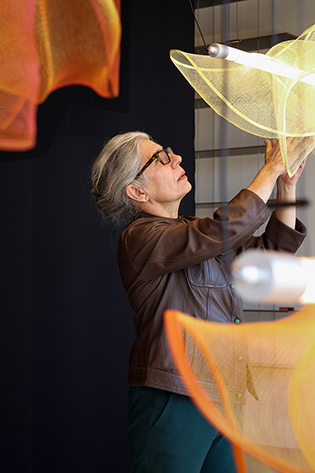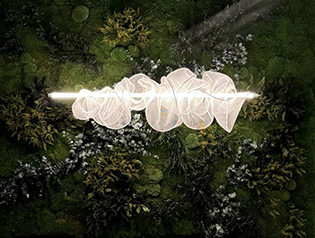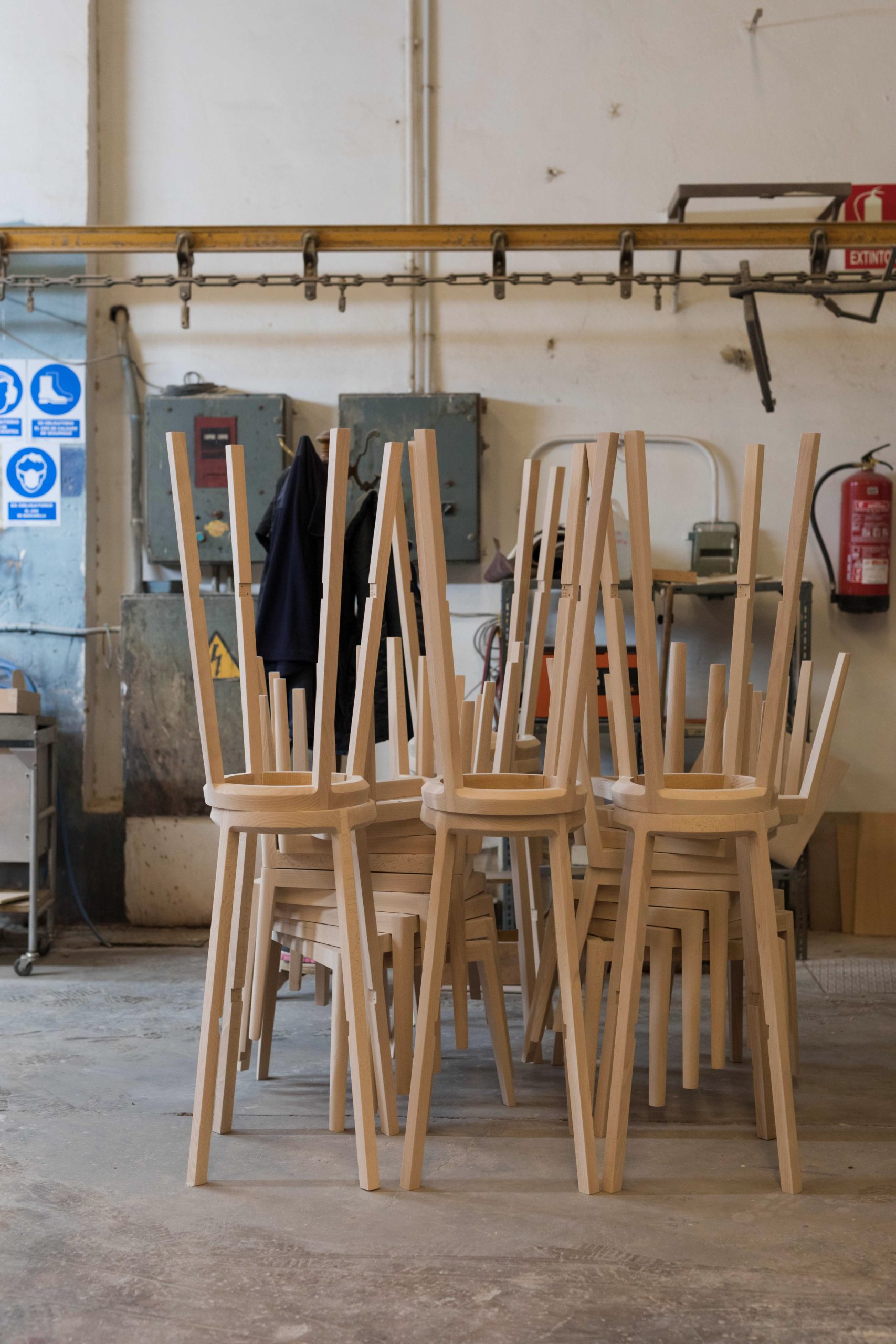‘I aim to design jewellery as art to be worn throughout life.’ This sentiment, expressed by Helena Rohner, beautifully captures the essence of her craft. For Helena, her jewellery is a form of sculpture: expertly crafted by hand, every piece is expressive and full of emotion. On the whole her jewellery is simple and self-effacing, classic and refined, open and inviting. Many pieces have a gender fluidity, something that sets Helena’s work apart.

Helena Rohner.
Helena Rohner was born in the Canaries, whose islands are largely unspoiled. In many ways, her jewellery captures the essence of this sparkling, sunny, and diverse archipelago—as well as gold and silver, Helena’s jewellery incorporates porcelain, colourful, semiprecious stones, wood, Japanese string, and PLA 3D—an organic, biodegradable material made using 3D printing techniques. Now residing in Madrid, Helena discovered a city with a rich history of craftsmanship. Immersing herself in its craft and culture, she produces much of her jewellery in the Spanish capital.
Helena Rohner’s portfolio is eclectic and she has enjoyed creative collaborations with a number of brands, including: Georg Jensen, Kähler, Dac Rugs, Ferm Living, Gancedo, and Teixidors. Helena is currently collaborating on a new lighting project with LZF, and we were extremely keen to feature her as part of our people with character series.
Meet Helena Rohner
What are five words that best describe you?
(HR) Curious, softly rebellious, colourful, small, tenacious.
I wonder what it is you find most fascinating about jewellery?
(HR) I love the timid sculpture part of it. I use a lost wax casting technique, where I carve and shape in hard wax. The wax is melted within a mould, creating a hollow where the metal is then cast. To this I add other materials, such as wood, porcelain, and stone, forming an object that can be worn.

Jewellery by Helena Rohner.
Your jewellery is described as if it were ‘shaped not by a human hand, but by nature’s elements.’ Can you say more… what is your creative process?
(HR) I am very inspired by organic forms, like those found in nature, and also by people and art. I am most comfortable with soft shapes, so I guess my jewellery reflects the shapes in nature.
What do you think about the idea of jewellery as wearable art?
(HR) For sure, it is wearable sculpture. I aim to design jewellery as art to be worn throughout life—it reflects the user’s personality and blends into the individual. I like to think of it as ‘leave on’ jewellery.
You have worked on a number of collaborations, for example designing rugs for Dac Rugs and objets d’art for Georg Jensen. What do you look for in a collaborative relationship?
(HR) I am most interested in learning and in pushing the limits of possibilities, for example, by combining materials. I enjoy making pieces that may surprise, even if just subtly. In a collaboration with Danish brand Georg Jensen, I added porcelain to steel, opening up a new way of giving warmth to this shiny, colder metal. With Kähler, another Danish brand, I designed a USB port as a wearable porcelain pendant: the ‘My Life’ USB. In bringing together technology and craft, the pendant won a Red Dot Design Award.

Georg Jensen teapot and accessories.

Dac Rugs Susan rug.
Working with Spanish brand Dac Rugs, I crafted designs that combine jute with wool, and present knots that are more characteristic of tapestry. For Danish brand Ferm Living, I designed knobs that are surprisingly weighty. Made from solid brass or stainless steel, their ergonomic shapes—a chanterelle mushroom and a lemon—caress the hand. With Spanish textile company Gancedo, I designed ‘pebbles’, a series of pouffes with a macaroon-like shape. Combining velvet and linen, the pouffes showcase the beautiful textiles from Gancedo’s collection. And I worked with Barcelona-based Teixidors, a social weaving project, to design cashmere shawls in bright, lively colours. Made by skilled weavers, the shawls have an almost colour therapy-like effect.

Ferm Living Mushroom and Lemon hooks.

Gancedo Pebbles.

Teixidors Pluyia shawl.
My interest in collaborating is always sparked by a curiosity I have for placing myself in another company’s world, where I can humbly add something of my own. I love the social and psychological aspects too: understanding where the vision is, how the company works, and linking at a personal level with those behind it. My career is actually in politics—I have a degree in International Relations from the London School of Economics—so I guess this is where I make that link. And design, after all, has a very social component.
I know you can’t give too much away, but you’re collaborating on a new lighting project with LZF. What attracted you to working with the company?
(HR) I love the honesty of the company, the fluid forms it represents, and the two beautiful people behind it. LZF has a notably human perspective on design, something I find most endearing in these times. And then I love light—designing a lamp is an amazing challenge. There is so much to learn, not least technically. It’s all very exciting.
Living and working in Madrid, what is your relationship with the city—how has it shaped your creativity?
(HR) Madrid is bathed in a warm yellow light, its colours are intense, and life is quite easy for a big city. I live in the La Latina neighbourhood, walk to work, and enjoy a local life with the bonus of having big museums and parks nearby. When I moved to Madrid from London, I realised the potential there was in the city’s craftsmanship. Therefore, when I started selling internationally, I decided my labour should reflect this and thus I produce as much as I can here. I am also very hands-on when designing, and working day-to-day with woodworkers, stonecutters, and ceramicists is perfect. I’m always learning and have a capacity for improvisation.

Jewellery expertly crafted by hand.
Scrolling through the jewellery on your website, you have a wonderfully eclectic and inviting collection of pieces. It isn’t something that I necessarily find when looking at jewellery (in general) and I wonder what, in your opinion, sets you apart?
(HR) My jewellery isn’t easily classified in a particular genre. By this I mean it isn’t high-end jewellery, and it isn’t bijouterie either. There is a strong craft component within it, and I guess this permeates through the pieces. Each one is handmade and holds a soulful essence.
I consider a lot of your jewellery designs to be gender-fluid (although I know you have defined categories for women and men). Have you observed an increasing blurring of the boundaries between men and women in terms of jewellery design?
(HR) Yes, certainly. In fact I design my women’s collection, then strip it down, creating what might be considered a more masculine version. However, there are actually many pieces that exist for both men and women, and we have clients who order men’s jewellery for women and vice versa—Paul Smith is just one example. Interestingly enough, I find the same thing has happened across cultures, where the differences in cultural appreciation have blurred. Twenty-five years ago, when I began designing jewellery, there was a clear distinction in the shapes or colours that someone from Japan would buy vis-à-vis someone from the USA or Spain. Nowadays, clients are much more cosmopolitan, with a similar appreciation of art and craft throughout the world.

Open band ring.

Barbara wood L necklace.

Mirror organic M bracelet.
Do you have any fantasies about who you would love to see wearing your jewellery?
(HR) I design jewellery so people can wear it and make it their own—that’s my challenge. I’m excited when I see someone unknown to me wearing a piece, and I love it when clients tell me how they’ve worn a ring or a pendant for a long and important period of their life. There are ‘famous’ people who wear my jewellery and it is exciting. But, what I wish for most, is simply to design a small sculpture that will accompany, and become one with, the wearer.
All photos © Helena Rohner.













